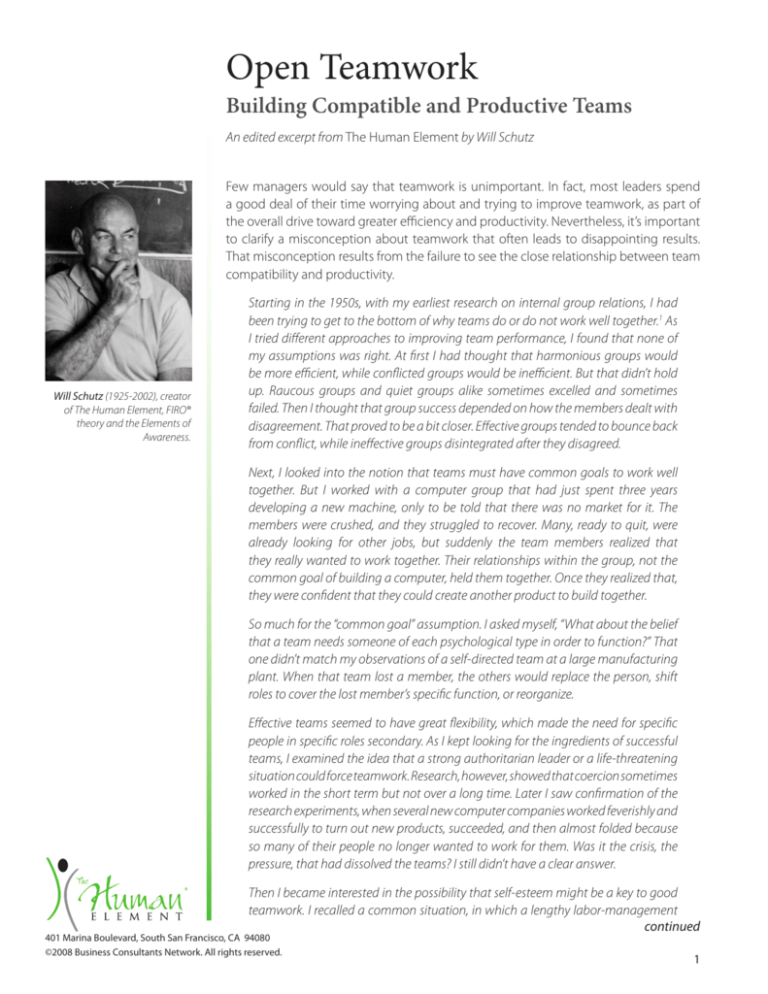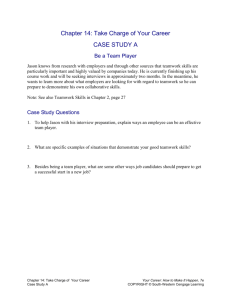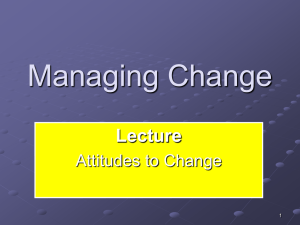
Open Teamwork
Building Compatible and Productive Teams
An edited excerpt from The Human Element by Will Schutz
Few managers would say that teamwork is unimportant. In fact, most leaders spend
a good deal of their time worrying about and trying to improve teamwork, as part of
the overall drive toward greater efficiency and productivity. Nevertheless, it’s important
to clarify a misconception about teamwork that often leads to disappointing ­results.
That misconception results from the failure to see the close relationship between team
compatibility and productivity.
Will Schutz (1925-2002), creator
of The Human Element, FIRO®
theory and the Elements of
Awareness.
Starting in the 1950s, with my earliest research on internal group relations, I had
been trying to get to the bottom of why teams do or do not work well together.1 As
I tried different approaches to improving team performance, I found that none of
my assumptions was right. At first I had thought that harmonious groups would
be more efficient, while conflicted groups would be inefficient. But that didn’t hold
up. Raucous groups and quiet groups alike sometimes excelled and some­times
failed. Then I thought that group success depended on how the members dealt with
disagreement. That proved to be a bit closer. Effective groups tended to bounce back
from conflict, while ineffective groups disintegrated after they disagreed.
Next, I looked into the notion that teams must have common goals to work well
together. But I worked with a computer group that had just spent three years
developing a new machine, only to be told that there was no market for it. The
members were crushed, and they struggled to recover. Many, ready to quit, were
already looking for other jobs, but suddenly the team members realized that
they really wanted to work together. Their relationships within the group, not the
common goal of building a computer, held them together. Once they realized that,
they were confident that they could create another product to build together.
So much for the “common goal” assumption. I asked myself, “What about the belief
that a team needs someone of each psychological type in order to function?” That
one didn’t match my observations of a self-directed team at a large manufacturing
plant. When that team lost a member, the others would replace the person, shift
roles to cover the lost member’s specific function, or reorganize.
Effective teams seemed to have great flexibility, which made the need for specific
people in specific roles secondary. As I kept looking for the ingredients of successful
teams, I examined the idea that a strong authoritarian leader or a life-threatening
situation could force team­work. Research, however, showed that coercion sometimes
worked in the short term but not over a long time. Later I saw confirmation of the
research experiments, when several new computer companies worked feverishly and
successfully to turn out new products, succeeded, and then almost folded because
so many of their people no longer wanted to work for them. Was it the crisis, the
pressure, that had dissolved the teams? I still didn’t have a clear answer.
Then I became interested in the possibility that self-esteem might be a key to good
teamwork. I recalled a common situation, in which a lengthy labor-management
continued
401 Marina Boulevard, South San Francisco, CA 94080
©2008 Business Consultants Network. All rights reserved.
Open Teamwork
dispute is eventually settled on almost the same terms the two sides fought over
in the beginning. I had already seen how rigidity leads to defensive, unproductive
individual behavior. Connecting that work to my thinking about teamwork
suggested that good teamwork occurred when team members (1) were open
enough to one another and to themselves to recognize when they were personally
threatened and (2) were willing to acknowledge those feelings to the whole team.
Team members who feel threatened but who are not aware of it become rigid—
and that stops teamwork.
In other words, teams do not fail because they disagree, or because they do not have
common goals, or because their members’ approaches to solving problems differ,
or because they do not include certain personality types. They don’t work because
one or more people are rigid, and a person is rigid because his or her self-concept is
threatened.
Understanding
the connection
between
compatibility
and productivity
is crucial to
understanding
the vital role of
good teamwork.
What a wonderful irony. If we want to improve team performance, we must work
on individuals.
Most real interpersonal struggles—peace negotiations, labor issues, divorces—have to
do mainly with feelings, fears, insecurities, and rigidities, not primarily with the logic of
a situation. Understanding the connection between compatibility and productivity is
crucial to understanding the vital role of good teamwork.3
Compatibility—the ability of people to work well together—is positively related
to productivity. A common organizational myth is that there is no time to deal with
personal relationships; there are deadlines, bottom lines, and payrolls to meet, and
they take priority. But ignoring teamwork problems in favor of “practical” matters is the
expression of a massive organizational self-deception. It is more true to say that an
organization cannot afford not to take the time to deal with relations between people;
otherwise, those relations inevitably affect productivity, often in a devastating way.
When interpersonal problems exist but are not dealt with, the organization’s productivity
inevitably diminishes; how much depends on the task. Some tasks require cooperation
in order to be done well. Other jobs can be done by one person just as well as (and
sometimes better than) by a group. Many jobs can be organized either to require
cooperation or to be accomplished independently. The effect of compatibility on
productivity is greatest for tasks in which cooperation is necessary to the achievement
of results. Experiments4 have demonstrated that compatible groups perform even
better under time pressure than they do without pressure, while incompatible groups
become less effective.
Compatibility
Lack of rigidity is basic to good teamwork, but my ability to work with others depends
to a large extent on our compatibility and complementarity—that is, on the ability of
our personalities or styles to enhance each other, supply each other’s missing traits, and
support each other. The phrases “birds of a feather flock together” and ­“opposites attract,”
apparently contradictory, can thus be reconciled. The “birds of a feather” maxim is related
to atmosphere compatibility—that is, the climate, ground rules, or stage setting within
401 Marina Boulevard, South San Francisco, CA 94080
©2008 Business Consultants Network. All rights reserved.
continued
Open Teamwork
which we interact. The “opposites attract” maxim has to do with role compatibility—that
is, the parts we wish to play.
Atmosphere Compatibility
When
interpersonal
problems exist
but are not
dealt with, the
organization’s
productivity
inevitably
diminishes.
In an organization, I may prefer different types of atmospheres that can be located
along the dimensions of inclusion, control, and openness. The term atmosphere refers
to the working environment and approaches to decision making. The atmosphere is
composed of shared behavior, beliefs, values, and settings and may incorporate different
levels and types of inclusion, control, and openness. No one type of atmosphere is
necessarily good or bad. Each type has advantages and disadvantages, which depend
on the organization, the people, and the tasks. Brainstorming is usually best in a highinclusion, low-control atmosphere. Getting work done in a short time is more efficient in
a high-control, low-openness (that is, structured and businesslike) atmosphere, where
everything is planned and well organized.
Incompatibility in inclusion occurs when some of us like a high-inclusion atmosphere
while others prefer a low-inclusion atmosphere. I may want to get together and interact
with you, while you want to be left alone.
Control preferences can likewise affect compatibility within teams. Incompatibility can arise
when some members want a clear power structure, with everything planned out ahead of
time, and others want an egalitarian structure, with everyone participating in decisions.
Openness in atmosphere has to do with preferences about the expression of feelings.
Incompatibility arises when you want an emotionally open atmosphere and I want
to stick to business. The issue is not so much our disagreement itself as our lack of
agreement over how to resolve our differences. Our difficulty persists when you or I
hold rigidly to our position.
Role Compatibility
Role compatibility involves the parts we play with respect to each other as we interact
in the work atmosphere. There are two types of role incompatibility: you and I are
confrontive (that is, we both want to initiate behavior, but neither of us wants to be
the recipient); or we are apathetic (that is, we both want to be on the receiving end of
behavior, but neither of us wants to initiate it).
Confrontive incompatibility is usually overt and obvious. It leads to open confrontation,
power struggles, and turf wars. Apathetic incompatibility is covert and difficult to
identify. Its most noticeable symptom is that nothing happens when it should. Nobody
does anything, because someone else is supposed to do it. Role incompatibility can
likewise be explained in terms of the dimensions of inclusion, control, and openness.
Where inclusion is concerned, compatibility means that I like to initiate being together
to the same degree that you like to be asked to get together. Confrontive incompatibility
arises when we both strongly want to initiate inclusion, but neither of us wants to be
included; we both want to choose our own company. Apathetic incompatibility arises
when we both want to be included, but we both hang back, waiting for an invitation,
without offering one ourselves.
continued
401 Marina Boulevard, South San Francisco, CA 94080
©2008 Business Consultants Network. All rights reserved.
Open Teamwork
Where control is concerned, role compatibility means that each of us likes to give orders
to the same degree that the other likes to take them. Confrontive incompatibility arises
when we both like to be in charge, and neither of us likes to take orders. Apathetic
incompatibility arises when we are both submissive and want to be told what to do.
In the openness dimension, role compatibility means that each of us likes to initiate
openness to the same degree that the other likes to have it initiated. Confrontive
incompatibility arises when we both want to initiate openness, but neither of us wants
to have it initiated toward us. Apathetic incompatibility arises when we both want to
have a more open relationship, but neither of us will risk initiating it.
The Open
Teamwork
method relies
on a new level of
consciousness to
break through
conflicts and
stalemates.
If blocks to teamwork are due to individual rigidities and unresolved issues between
people, how can these difficulties be overcome to create highly productive teams?
Traditional approaches—coercion, compromise, and complementarity—try to solve
the problems of teamwork through logic or power. But trying to solve them by deciding
whose argument is more logical does not always yield the best solution.
The Open Teamwork method relies on a new level of consciousness to break through
conflicts and stalemates. If all parties to a disagreement become more self-aware, we
have an entirely new basis for resolving our differences.
Openness as a model for teamwork is a radical notion. Typical organizations do not
often reward openness and self-insight. They are more likely to foster such behavior as
denial and “spin control,” as well as a general strategy of my getting what I want from
people without their knowing what I have done. To reveal a weakness, or to tell you
directly how I feel about you, is a rare and often risky act.
Yet it does work, often magically. If I want to improve teamwork, I must know all the
human factors blocking it and then remove them by getting them out in the open for
the whole team to see and deal with. I can then enlist the abilities of the entire team
to create a ­solution that incorporates all these factors, including satisfying the feelings
that created them.
Open teamwork has proved to be the key that unlocks a great productivity surge. It has
resulted in decreased time to market, greatly reduced time required for meetings, more
efficient and satisfying working conditions resulting in higher motivation, greater unionmanagement cooperation, and increased profitability. For example, the “traditional
packing start-up curve—the time between the concept and full production—is
about 22 months .... The in-case fill start-up at Baltimore [using The Human Element
approach] took about four months. This saved the company ... $9 million compared
to the average start-up.” Or, as another client reported, “Union and plant leadership
attended the [Human Element] workshop. Two weeks after the workshop the union
and the company signed an unprecedented amendment to the current contract ....
Both the union and plant leadership attribute the success of the negotiations ... to the
workshop. Headquarters was prepared to shut down the plant if there was no signed
agreement.”4
401 Marina Boulevard, South San Francisco, CA 94080
©2008 Business Consultants Network. All rights reserved.
Open Teamwork
Behavior That Enhances Teamwork
1. I am open at all times about my feelings and my ideas. I keep no secrets from
myself or others.
2. I say what I feel about whatever is relevant at the moment when I feel it.
3. I stay aware of myself—of what is motivating me and of what I am feeling
at every moment. I am aware of the deepest levels of truth. I do not deceive
myself.
4. I assume that all team members are on the same side, trying to produce the
best solutions to the team’s problems, and not trying to protect themselves
or blame others.
5. I make sure that each person fully agrees—with head, heart, and feelings—
on each decision.
6. I listen to others’ thoughts and feelings. I empathize with each person’s point
of view, acknowledge it, and state my honest reaction to it.
7. When I understand each person’s point of view and feelings, I begin to seek a
solution that integrates all the ideas and feelings of all team members.
8. I am aware of differences in atmosphere preference and am sure to say, in a
timely fashion, how I feel. I stay in touch with my deepest levels of truth.
9. I make sure that we agree on our mission, vision, and goals. I am aware that
these often change as we get farther into a task. I do not hesitate to change
them if we all agree that change would be appropriate.
10. I participate in meetings to decide specifically how decisions will be made.
These meetings are about the process of our decision making, not about any
of our specific decisions.
From The Human Element by Will Schutz, ©1994, 2005 Business Consultant Network, Inc.
References
1. Schutz, W., (2000). The Human Element Leaders’ Manual. South San Francisco, CA: Business Consultants
Network.
2. Schutz, W. “What Maks Groups Productive?” Human Relations, 1955,8(4), 429-465.
3. Schutz, W., (1989). FIRO: A Three-Dimensional Theory of Interpersonal Behavior. South San Francisco, CA:
Business Consultants Network.
4. Data are available upon request from Business Consultants Network at info@BConNetwork.com or
(800) 462-5874.
FIRO is a registered trademark of Consulting Psychologists Press, Inc.
401 Marina Boulevard, South San Francisco, CA 94080
©2008 Business Consultants Network. All rights reserved.






![Teamwork [doc]](http://s3.studylib.net/store/data/007119492_1-4f52bf0b0aa8b7482c84777d359de0b7-300x300.png)
